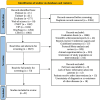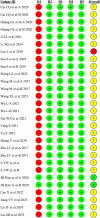Is acupuncture combined with repeated transcranial magnetic stimulation more effective in improving upper limb motor dysfunction after stroke? A systematic review and meta-analysis of randomized controlled trials
- PMID: 40529441
- PMCID: PMC12171305
- DOI: 10.3389/fneur.2025.1575879
Is acupuncture combined with repeated transcranial magnetic stimulation more effective in improving upper limb motor dysfunction after stroke? A systematic review and meta-analysis of randomized controlled trials
Abstract
Background: Upper limb motor dysfunction is a common sequela of stroke, which adversely affects patients' quality of life and ability of daily living. Although acupuncture and repeated transcranial magnetic stimulation (rTMS) can improve this symptom, it is uncertain whether the combined application of the two treatments can enhance the therapeutic effect.
Objective: Through systematic review and meta-analysis, this study discusses the improvement effect of acupuncture combined with rTMS on upper limb motor dysfunction after stroke.
Methods: We searched PubMed, Cochrane Library, Embase, Web of Science, China National Knowledge Infrastructure (CNKI), Chinese Scientific Journals Database (VIP), Wanfang Database, and Chinese Biomedical Literature Service (CBM) for randomized controlled trials of acupuncture combined with rTMS for the treatment of upper limb motor dysfunction after stroke, and performed a screening process according to the inclusion and exclusion criteria. The data were screened, extracted, and analyzed using RevMan (version 5.4) software for Meta-analysis.
Results: A total of 21 papers involving 1,550 patients were included. The results of the Meta-analysis showed that the combination therapy was superior to acupuncture alone and rTMS alone in improving FMA-UE (acupuncture: MD = 7.55, 95%CI: 4.18 ~ 10.92, I2 = 97%, p < 0.00001; rTMS: MD = 9.74, 95%CI: 6.41 ~ 13.07, I2 = 98%, p < 0.00001); combination therapy was superior to acupuncture alone and rTMS alone in improving MBI (acupuncture: MD = 6.43, 95%CI: 4.07 ~ 8.78, I2 = 61%, p = 0.01; rTMS: MD = 9.49, 95%CI: 7.52 ~ 11.47, I2 = 39%, p = 0.12); combination therapy was more effective in improving MAS compared to acupuncture (MD = -0.55, 95% CI: -0.69 to -0.41, I2 = 0%, p = 0.61); combination therapy was more effective in improving NIHSS compared to rTMS (MD = -3. 14, 95%CI: -4.79 to -1.5, I2 = 74%, p = 0.02).
Conclusion: Acupuncture combined with rTMS is more effective than acupuncture or rTMS intervention alone in improving upper extremity motor function and daily living ability and improving neurological damage after stroke.
Keywords: acupuncture; meta-analysis; repeated transcranial magnetic stimulation; stroke; upper limb motor dysfunction.
Copyright © 2025 Yan, Luo, Hou, Wang and Yang.
Conflict of interest statement
The authors declare that the research was conducted in the absence of any commercial or financial relationships that could be construed as a potential conflict of interest.
Figures
Similar articles
-
Acupuncture combined with repeated transcranial magnetic stimulation for upper limb motor function after stroke: A systematic review and meta-analysis.NeuroRehabilitation. 2023;53(4):423-438. doi: 10.3233/NRE-230144. NeuroRehabilitation. 2023. PMID: 38143390
-
Examining the effectiveness of motor imagery combined with non-invasive brain stimulation for upper limb recovery in stroke patients: a systematic review and meta-analysis of randomized clinical trials.J Neuroeng Rehabil. 2024 Nov 30;21(1):209. doi: 10.1186/s12984-024-01491-x. J Neuroeng Rehabil. 2024. PMID: 39616389 Free PMC article.
-
Comparative efficacy of different noninvasive brain stimulation protocols on upper-extremity motor function and activities of daily living after stroke: a systematic review and network meta-analysis.Neurol Sci. 2024 Aug;45(8):3641-3681. doi: 10.1007/s10072-024-07437-4. Epub 2024 Mar 23. Neurol Sci. 2024. PMID: 38520639
-
Efficacy of Robot-assisted Training on Upper Limb Motor Function After Stroke: A Systematic Review and Network Meta-analysis.Arch Rehabil Res Clin Transl. 2024 Dec 17;7(1):100387. doi: 10.1016/j.arrct.2024.100387. eCollection 2025 Mar. Arch Rehabil Res Clin Transl. 2024. PMID: 40463769 Free PMC article. Review.
-
Effects of multi-site non-invasive brain stimulation on cognitive impairment after stroke: a systematic review and meta-analysis.Front Hum Neurosci. 2025 Jun 30;19:1583566. doi: 10.3389/fnhum.2025.1583566. eCollection 2025. Front Hum Neurosci. 2025. PMID: 40661748 Free PMC article.
References
-
- Feigin VL, Roth GA, Naghavi M, Parmar P, Krishnamurthi R, Chugh S, et al. Global burden of stroke and risk factors in 188 countries, during 1990-2013: a systematic analysis for the global burden of disease study 2013. Lancet Neurol. (2016) 15:913–24. doi: 10.1016/S1474-4422(16)30073-4, PMID: - DOI - PubMed
-
- Cai C, Liu X, Zheng Q, Xiao K, Gao Z, Zhu S. Effect of electric scalp relay acupuncture combined with low frequency repetitive transcranial magnetic stimulation on upper limb motor dysfunction and motor evoked potentials after stroke. Modern J Integr Tradit Chin West Med. (2020) 29:2658–62.
-
- Cao X, Pu X, Ma W, Xu G, Zhang W. Kāiqiàotōngluò acupuncture combined with repetitive transcranial magnetic stimulation for the treatment of hand dysfunction after stroke. World J Acupunct-Moxibustion. (2022) 32:137–41.
-
- Huang G, Xu Y, Liang C, Chen M, Jia C, Su B. Effect of spasm three-needle therapy combined with repetitive transcranial magnetic stimulation on spasticity of upper extremity after stroke based on sEMG. Guid J Tradit Chin Med Pharm. (2020) 26:98–100.
Publication types
LinkOut - more resources
Full Text Sources









